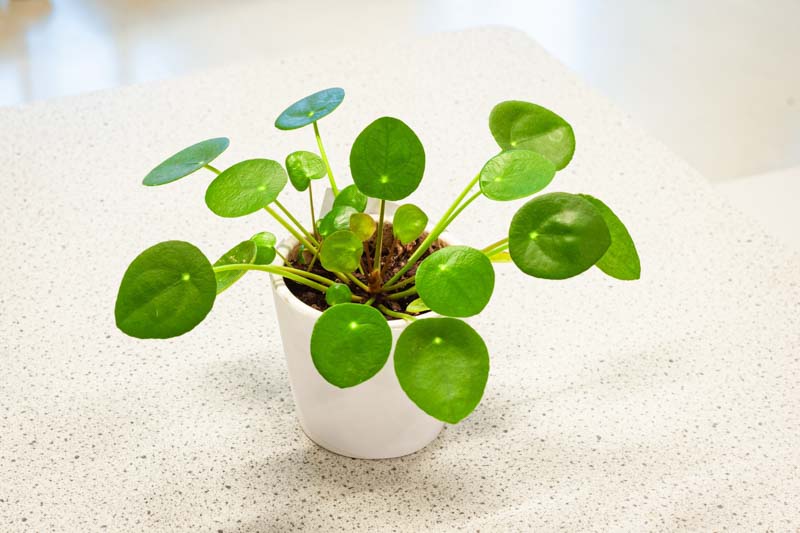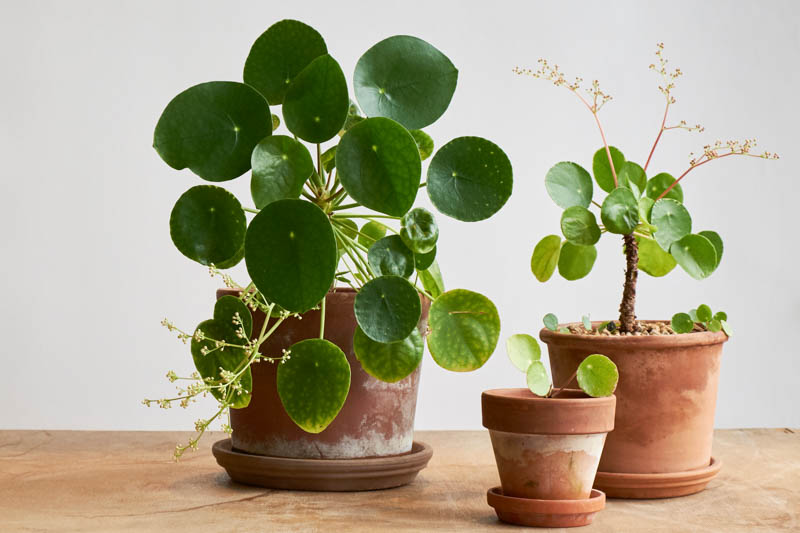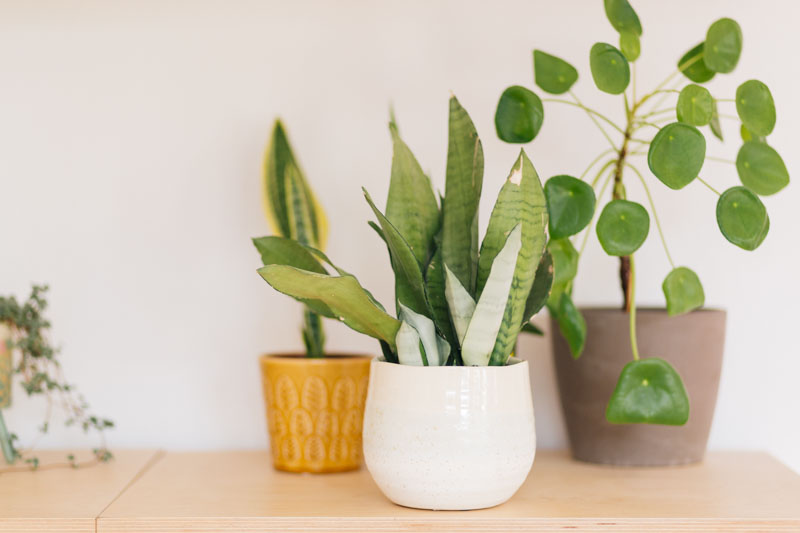Chinese Money Plant, Pancake Plant, Coin Plant, UFO Plant, Friendship Plant, Missionary Plant
Pilea peperomioides, commonly known as the Chinese Money Plant, UFO Plant, or Pancake Plant, is a popular houseplant cherished for its unique appearance and ease of care. Originating from the southwestern Yunnan province of China, this plant has captivated plant enthusiasts worldwide, thanks to its distinctive round, coin-like leaves.
The Chinese Money Plant features a compact, bushy growth habit, characterized by its bright green, circular leaves that sit on long petioles, giving the appearance of a small lily pad or coin floating in the air. The plant’s charm lies in its symmetry and the playful way its leaves turn towards the light.
Native: This plant is native to the Yunnan Province in southern China, where it grows in shady, cool mountain regions. It was largely unknown to the Western world until the mid-20th century. It belongs to the nettle family (Urticaceae) and is part of a diverse genus with over 600 species.
Plant Type and Habit: It is an evergreen perennial with an upright, clump-forming habit. The Chinese Money Plant grows as a short-stemmed, compact plant, making it ideal for indoor cultivation.
Size: The Chinese Money Plant typically grows about 8 to 12 inches tall and wide (20-30 cm), although it can reach up to 18 inches (45 cm) in optimal indoor conditions.
Flowers: This plant produces small, white to pinkish flowers on a tall spike, though flowering is infrequent and less common in indoor settings.
Foliage: The foliage is the most notable feature, with fleshy, round, dark green leaves, 4 inches across (10 cm), that can create a dense and lush appearance. The leaves’ unique shape and structure have contributed significantly to its popularity.
Hardiness: It is suited for USDA hardiness zones 9-11 if grown outdoors, but it is predominantly kept as an indoor plant due to its sensitivity to cold temperatures.
Award: Recipient of the prestigious Award of Garden Merit of the Royal Horticultural Society.
Uses: Primarily used as an ornamental indoor plant, it’s perfect for tabletops, shelves, and as a striking component of a mixed plant collection. Its aesthetic appeal adds a modern touch to home and office spaces.
Toxicity: One of the plant’s benefits is its non-toxicity; it is safe for pets and humans, making it a family-friendly indoor plant option.
Benefits: Apart from its visual appeal, it is known for its air-purifying qualities, contributing to a healthier indoor environment. It also has a high transpiration rate, which can help increase indoor humidity.

Caring for a Chinese Money Plant is straightforward, making it an ideal choice for both novice and experienced plant enthusiasts. Here are the essential care tips to keep your Chinese Money Plant thriving:
Light: Bright, indirect sunlight. Too much direct sunlight can scorch the leaves, while too little light can cause leggy growth. Near a window that receives ample sunlight throughout the day, filtered through a sheer curtain to avoid direct exposure.
Soil: A well-draining, peat-based potting mix is ideal. You can also mix in perlite or sand to improve drainage.
Water: Water when the top inch of the soil feels dry to the touch. Overwatering can lead to root rot, so ensure good drainage. Use room temperature water to avoid shocking the plant.
Temperature and Humidity: Prefers temperatures between 60-75°F (15-24°C). Avoid placing it in drafty areas or near heat sources. Chinese Money Plant enjoys moderate to high humidity but can tolerate average household humidity levels.
Fertilization: Feed with a balanced, liquid fertilizer diluted to half strength once a month during the growing season (spring and summer). Reduce feeding in the fall and winter.
Pruning: Trim off any yellow or damaged leaves to keep the plant looking tidy. You can also pinch off the tips to encourage bushier growth.
Rotating: Regularly rotate your plant to ensure even growth on all sides, as it tends to lean towards the light source.
Repotting: Repot every 2-3 years in spring or when the plant becomes root-bound. Spring is the best time to repot. Choose a pot that is slightly larger than the current one, with adequate drainage holes.
Propagating a Chinese Money Plant is a simple and rewarding process. This plant readily produces offsets (also known as “pups”) from its base, which can be used to grow new plants. Here’s how to propagate your Chinese Money Plant:

The Chinese Money Plant is generally easy to care for but, like all plants, can encounter pests, diseases, and common problems.
Spider Mites: These tiny pests can be identified by the fine webs they weave on the plant. They cause yellowing or speckled leaves. Increase humidity around the plant and wash it with a strong stream of water. For severe infestations, use insecticidal soap or neem oil.
Mealybugs: These white, cottony pests tend to cluster in leaf axils and under leaves, sucking sap and weakening the plant. Remove with alcohol-dipped cotton swabs or apply neem oil.
Fungus gnat: Overwatering can lead to these pests. Let the soil dry out more between waterings, and use yellow sticky traps to catch adult gnats.
Scale insects: Hard or soft-bodied insects that attach themselves to the stems or leaves, causing yellowing and growth stunting. Scrape off with a fingernail or use a cotton swab dipped in rubbing alcohol. Insecticidal soap or neem oil may also be used.
Root rot: Often a result of overwatering, leading to brown, mushy roots and wilted leaves. Prevent by ensuring good drainage and letting the soil partially dry between waterings. Affected plants may need repotting with fresh soil after cutting away any rotten roots.
Leaf spot: Fungal or bacterial infections causing spots on leaves. Avoid wetting foliage when watering and improve air circulation. Remove affected leaves and treat with fungicides if necessary.
Drooping Leaves: Often a sign of underwatering. Check the soil moisture and water accordingly.
Yellow Leaves: Can be caused by overwatering, poor drainage, or nutrient deficiency. Adjust watering habits and ensure the pot has good drainage.
Brown Leaf Edges: Typically due to low humidity or over-fertilization. Increase humidity around the plant and reduce the frequency of fertilization.
Leggy Growth: Indicates insufficient light. Move your plant to a brighter location with indirect sunlight to encourage compact growth.

The Chinese Money Plant (Pilea peperomioides) is predominantly grown as an indoor plant, especially in climates that experience colder temperatures. Its adaptability to indoor environments, including low-light conditions and typical household humidity levels, makes it a popular choice for interior decoration. In warmer climates (USDA zones 9-11), it can be grown outdoors in shaded areas where temperatures do not drop below 50°F (10°C).
While there is no scientific evidence to suggest that the Chinese Money Plant brings monetary wealth, it is often associated with good fortune and prosperity in Feng Shui and other cultural beliefs. Its coin-shaped leaves are seen as symbols of wealth, making it a popular gift with the hope of bringing financial luck.
The Chinese Money Plant prefers bright, indirect sunlight. Direct exposure to harsh sunlight can scorch its leaves, while too little light can cause leggy growth. A spot near a window with sheer curtains or a little distance away from a sunny window is ideal.
Yes, you can put your Chinese Money Plant outside in the summer, provided it is kept in a shaded or partially shaded area to avoid direct sunlight. Make sure to bring it back indoors before temperatures drop in the fall.
Water your Chinese Money Plant when the top inch of soil becomes dry, typically once a week, but this may vary based on environmental conditions. It’s important to ensure the plant is not overwatered to avoid root rot. In winter, water less frequently as the plant’s growth slows down. Always use well-draining soil and a pot with drainage holes to prevent water from accumulating at the bottom.
| Hardiness |
9 - 11 |
|---|---|
| Plant Type | Houseplants, Perennials |
| Plant Family | Urticaceae |
| Genus | Pilea |
| Exposure | Partial Sun |
| Season of Interest |
Spring (Early, Mid, Late) Summer (Early, Mid, Late) Fall Winter |
| Height |
8" - 1' (20cm - 30cm) |
| Spread |
8" - 1' (20cm - 30cm) |
| Maintenance | Low |
| Water Needs | Average |
| Soil Type | Loam, Sand |
| Soil pH | Acid, Neutral, Alkaline |
| Soil Drainage | Well-Drained |
| Characteristics | Showy, Evergreen, Plant of Merit |
| Garden Uses | Patio And Containers |
| Hardiness |
9 - 11 |
|---|---|
| Plant Type | Houseplants, Perennials |
| Plant Family | Urticaceae |
| Genus | Pilea |
| Exposure | Partial Sun |
| Season of Interest |
Spring (Early, Mid, Late) Summer (Early, Mid, Late) Fall Winter |
| Height |
8" - 1' (20cm - 30cm) |
| Spread |
8" - 1' (20cm - 30cm) |
| Maintenance | Low |
| Water Needs | Average |
| Soil Type | Loam, Sand |
| Soil pH | Acid, Neutral, Alkaline |
| Soil Drainage | Well-Drained |
| Characteristics | Showy, Evergreen, Plant of Merit |
| Garden Uses | Patio And Containers |
How many Pilea peperomioides (Chinese Money Plant) do I need for my garden?
| Plant | Quantity | |
|---|---|---|
| Pilea peperomioides (Chinese Money Plant) | N/A | Buy Plants |
Create a membership account to save your garden designs and to view them on any device.
Becoming a contributing member of Gardenia is easy and can be done in just a few minutes. If you provide us with your name, email address and the payment of a modest $25 annual membership fee, you will become a full member, enabling you to design and save up to 25 of your garden design ideas.
Join now and start creating your dream garden!
Create a membership account to save your garden designs and to view them on any device.
Becoming a contributing member of Gardenia is easy and can be done in just a few minutes. If you provide us with your name, email address and the payment of a modest $25 annual membership fee, you will become a full member, enabling you to design and save up to 25 of your garden design ideas.
Join now and start creating your dream garden!